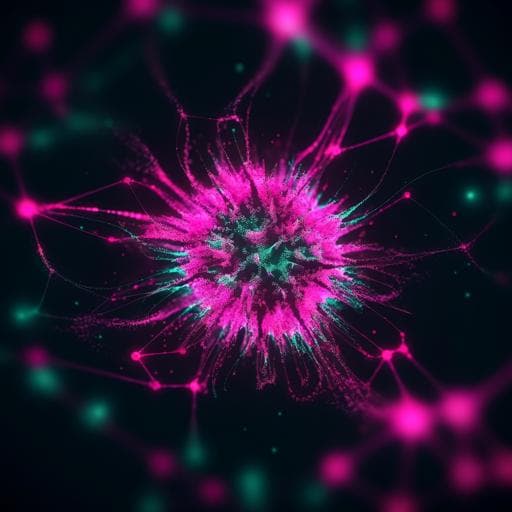
Medicine and Health
A one-two punch targeting reactive oxygen species and fibril for rescuing Alzheimer's disease
J. Wang, P. Shangguan, et al.
This groundbreaking research by Jiefei Wang and colleagues presents a novel near-infrared-II aggregation-induced emission (AIE) nanotheranostic aimed at combating Alzheimer's disease. It effectively penetrates the blood-brain barrier, binds to amyloid-beta plaques, and utilizes reactive oxygen species to mitigate plaque formation and inflammation, enhancing cognitive functions in a female AD mouse model.
~3 min • Beginner • English
Introduction
Alzheimer’s disease (AD) is a prevalent neurodegenerative disorder characterized by toxic amyloid-beta (Aβ) plaques and harmful inflammation that exacerbate each other, leading to oxidative stress, neuronal death, and synaptic loss. Existing therapeutics (e.g., acetylcholinesterase inhibitors, NMDA receptor antagonists, anti-inflammatory agents, monoclonal antibodies) are largely mono-targeted, suffer from limited specificity for both Aβ and inflammation, pose toxicity risks (e.g., high-dose aducanumab associated with brain edema and hemorrhage), and face poor efficacy due to the blood–brain barrier (BBB). Visual in vivo tracking is needed to guide precise drug design, yet available Aβ probes (such as ThT/ThS) lack BBB penetration, have short emission wavelengths (<715 nm), low sensitivity outside the NIR-II window, and are affected by aggregation-caused quenching with poor Aβ affinity, and lack therapeutic centers. The authors articulate the need for a dual-targeted, BBB-penetrating, high-sensitivity, NIR-II theranostic capable of imaging BBB traversal and Aβ binding while inhibiting fibrillization and reducing inflammation. They identify key design challenges: achieving strong Aβ affinity with a balanced conjugated twisted structure for bright NIR-II emission; incorporating multiple interaction sites for effective inhibition/degradation of fibrils; introducing a safe anti-inflammatory center; and engineering delivery/release/targeting for long circulation, BBB penetration, and lesion enrichment. The study proposes a co-assembled, ROS-responsive, brain-targeted NIR-II nanotheranostic to address these needs.
Literature Review
The paper situates prior work across AD therapeutics and imaging probes: approved AD drugs are mono-targeted and limited; clinical failures and toxicity remain common. Conventional Aβ fluorescent probes (ThT, ThS, PiB and others) are useful for ex vivo staining but unsuitable for in vivo applications due to poor BBB penetration, short emission wavelengths outside the high-sensitivity NIR-II range (1000–1700 nm), low quantum yields due to ACQ, and lack of therapeutic function. Prior AIE-based NIR probes and theranostics demonstrate benefits such as noninvasive imaging, deep penetration, and high S/N but often face trade-offs between long-wavelength absorption and emission brightness. Strategies highlighted include using donor–acceptor structures, twisted conformations to mitigate quenching, and incorporating groups (dimethylamino, diethylamino, hydroxy) that enhance Aβ binding. Anti-inflammatory strategies using reducing metal coordination (e.g., Ce(III)) are referenced for ROS scavenging. However, a paradigm achieving dual-target therapy with superior NIR-II emission and BBB penetration had been lacking.
Methodology
- Molecular design and synthesis: Two NIR-II AIE luminogens (AIEgens) were synthesized: compound 3 with 2,2′-azanediylbis(ethan-1-ol) termini for Aβ binding, and compound 6 incorporating terpyridyl-coordinated Ce(III) units for antioxidation; both share a central D–A–π framework with BBTD acceptor and alkylated thiophene bridges. Intermediates were characterized by NMR and HRMS.
- Nanocomposite fabrication: Compounds 3 and 6 were co-assembled using a ROS-responsive thioketal (TK)-linked amphiphilic polymer template (DSPE-TK-PEG) and modified with the BBB-targeting peptide angiopep-2 (Ang-2) to yield Ang-AIE nanocomposites (Ang-NCs). Size and morphology were assessed (DLS/TEM), composition verified (elemental mapping, FTIR for Ang-2), and optical properties measured (UV–vis–NIR absorption, PL emission, NIR-II imaging across channels).
- Photophysics and imaging: Emission/excitation spectra, aggregation-induced emission behavior, and in-solution/in vivo NIR-II imaging performance were evaluated, selecting 1350 nm as the optimal detection window for sensitivity and penetration.
- ROS-responsive behavior and antioxidation: ROS-triggered release was assessed via DLS (swelling/breakage in H2O2). Antioxidant activity was tested by catalysis of H2O2 to O2, ESR detection of •OH suppression in Fe3O4/H2O2 systems, and XPS to confirm Ce(III)→Ce(IV) oxidation.
- Anti-Aβ activities: TEM and DLS characterized Aβ42 species (monomer→oligomer→fibril), H2O2-induced fibril elongation, fibril degradation by NCs, inhibition of monomer aggregation, and prevention of fragment reaggregation. ThT-based inhibition assays yielded IC50. Binding affinity and selectivity of compound 3 for Aβ fibrils were studied by NIR titration (Kd-like value), competitive binding vs amino acids/proteins, and CD to assess secondary structure disruption.
- Computational studies: Aβ42 fibril structure (PDB 5KK3) prepared with AmberTools; DFT (B3LYP-D3/6-31G(d)) on 3; MD simulations (AMBER ff14SB for protein, GAFF for 3, TIP3P water) for 100 ns to characterize binding mode and interactions; MM/GBSA binding free energy; ONIOM and theozyme-level DFT calculations to refine binding energetics and interaction analyses (van der Waals, H-bonds, T-shaped π–π with histidine residues).
- In vitro studies: Cytotoxicity across cell lines (SH-SY5Y, PC12, BV2, Neuro-2a, HT-22). Cellular uptake (confocal/OD). In vitro BBB model (Transwell with bEnd.3) assessing Ang-2 enhancement. Aβ fibril degradation in cells (ThT staining). Antioxidant readouts: DCFH-DA (total ROS), MitoSOX (mitochondrial superoxide), JC-1 (mitochondrial membrane potential). Inflammatory markers (RT-PCR for TNF-α, IL-1β, IL-6; ELISA for IL-1β; Western blot for IL-1β, NLRP3, GPX4). Cell viability rescue assays with Aβ fibrils/oligomers/fragments and with isolated 3 vs 6 for function attribution. Crystal violet staining and Bio-TEM for mitochondrial integrity.
- In vivo studies: Female 7-month-old APP/PS1 AD mice; i.v. dosing of Ang-NCs (10 mg/kg) or PBS once every 3 days (6 doses). Safety: hemolysis assay; H&E of organs; blood biochemistry and hematology. Pharmacokinetics in Balb/c mice (half-life). NIR-II brain imaging at 1350 nm for BBB penetration and binding; biodistribution (organ imaging). Brain ROS assessment ex vivo (DCFH-DA), 8-OHdG staining. ELISA for TNF-α, IL-1β, Aβ1–42. Immunofluorescence on brain sections for Aβ plaques (Rabbit pAb anti-Aβ), astrocytes (GFAP), microglia (Iba-1); ThS staining; Prussian Blue for microbleeds. Behavioral tests: Nest construction (NC), Morris water maze (MWM; escape latency, time in target quadrant, platform crossings), Novel object recognition (NOR; recognition index). Statistical analyses via ANOVA or two-tailed t-tests as specified.
Key Findings
- Nanocomposite properties: Co-assembled Ang-NCs averaged 153.4 nm in size and exhibited strong NIR-II emission with absorption ~760 nm and emission peaking ~1070 nm with tail >1550 nm; optimal imaging at 1350 nm enabled high-sensitivity, across-skull cerebrovascular and brain imaging.
- Pharmacokinetics: Prolonged blood half-life for Ang-NCs (4.8 h) vs non-targeted NCs (3.9 h), supporting sustained circulation and BBB interaction.
- BBB penetration and targeting: In vitro Transwell and in vivo NIR-II imaging showed Ang-2 markedly enhanced BBB penetration and brain accumulation with higher 1350 nm signals vs non-targeted NCs. Ex vivo imaging indicated primary accumulation in liver and spleen.
- ROS-responsive release and antioxidation: H2O2 triggered NC swelling/fragmentation and release of payload. Ce(III) in compound 6 catalyzed H2O2 decomposition (O2 generation), reduced •OH in Fe3O4/H2O2 ESR assays, and was oxidized to Ce(IV) (XPS), indicating strong ROS scavenging capability.
- Anti-Aβ actions: NCs inhibited Aβ42 monomer aggregation and degraded pre-formed fibrils into amorphous fragments; they also suppressed reaggregation of fragments into longer fibrils. In contrast, ThT/ThS/PiB did not degrade fibrils.
• Binding of compound 3: NIR titrations yielded a dissociation constant of ~2.6 µM (comparable to ThT ~0.89 µM). 3 showed 7.7-fold higher binding to Aβ fibrils than DL-glutamine and perturbed fibril secondary structure (CD). MD and DFT/ONIOM analyses indicated multi-competitive interactions: van der Waals, H-bonds (e.g., with V318, V414), and T-shaped π–π stacking with histidines (H37, H100). MM/GBSA binding free energy ~ −35.8 kcal/mol supported tight binding.
• Inhibition potency: ThT kinetics assay gave IC50 = 9.67 µg/mL for NCs against Aβ monomer aggregation.
- In vitro neuroprotection and anti-inflammation: Ang-NCs reduced cellular ROS (DCFH-DA), mitochondrial superoxide (MitoSOX), and stabilized mitochondrial membrane potential (JC-1), restoring near-baseline levels. Pro-inflammatory mRNA (TNF-α, IL-1β, IL-6) and IL-1β protein decreased; Western blots showed downregulated IL-1β/NLRP3 and upregulated GPX4. Cell viability improved under Aβ fibril-induced toxicity in a dose-dependent manner; degraded Aβ fragments exhibited negligible cytotoxicity. Mitochondrial ultrastructure was preserved by Ang-NCs (Bio-TEM).
- In vivo efficacy in APP/PS1 female mice: After six i.v. doses (10 mg/kg), brain ROS decreased (ex vivo DCFH-DA; reduced 8-OHdG staining). ELISAs showed significant reductions in TNF-α, IL-1β, and Aβ1–42 (various P-values <0.05 to <0.0001). Aβ plaques in hippocampus and cortex were markedly reduced (ThS and anti-Aβ staining); microglia (Iba-1) and astrocyte (GFAP) activation decreased. No microbleeds detected by Prussian Blue.
- Behavioral improvements: Ang-NCs improved nest construction scores, reduced MWM escape latency, increased time in target quadrant and platform crossings, and elevated NOR recognition index to near WT levels.
- Safety: Minimal hemolysis; no notable histopathology in major organs; blood parameters comparable to PBS controls, indicating good biocompatibility.
Discussion
The study demonstrates a dual-target, brain-directed NIR-II nanotheranostic that integrates high-sensitivity imaging with synergistic therapy against the two central AD hallmarks: Aβ aggregation and neuroinflammation/oxidative stress. Ang-2 facilitates BBB crossing and lesion targeting, while ROS-responsive release initiates a self-enhanced program: compound 3 binds Aβ with multi-competitive interactions to inhibit fibrillization, disassemble existing fibrils, and prevent reaggregation; compound 6, via Ce(III)/Ce(IV) redox cycling, scavenges ROS and reduces inflammation, further supporting anti-amyloid effects. Together, these actions restore cellular redox balance, protect mitochondria, reduce inflammatory signaling (IL-1β/NLRP3), lower Aβ burden, and yield significant cognitive and behavioral improvements in an AD mouse model. Beyond providing a proof-of-concept, the authors distill design principles for future NIR-II neurotheranostics: engineering high Aβ specificity, combining multiple weak interactions for fibril disruption, leveraging redox-active metal coordination for antioxidation, optimizing structures for bright anti-quenching NIR-II emission, maximizing BBB penetration and biocompatibility, and employing disease microenvironment-responsive nanodelivery.
Conclusion
This work introduces a ROS-responsive, Ang-2-targeted NIR-II AIE nanotheranostic (Ang-NCs) that achieves across-skull, high-sensitivity imaging at 1350 nm and delivers synergistic therapy in AD by concurrently degrading Aβ fibrils and mitigating ROS-driven inflammation. Compound 3 provides potent Aβ binding, fibril inhibition/degradation, and anti-reaggregation via multi-competitive interactions; compound 6 offers robust antioxidation through Ce(III)-mediated ROS scavenging. In female APP/PS1 mice, Ang-NCs cross the BBB, reduce brain ROS and inflammatory cytokines, diminish plaque burden, normalize glial activation, and significantly improve behavioral and cognitive outcomes, with favorable pharmacokinetics and safety profiles. The authors propose generalizable guidelines for designing next-generation NIR-II neurotheranostics and suggest extending these strategies to other neurodegenerative diseases.
Limitations
Related Publications
Explore these studies to deepen your understanding of the subject.







